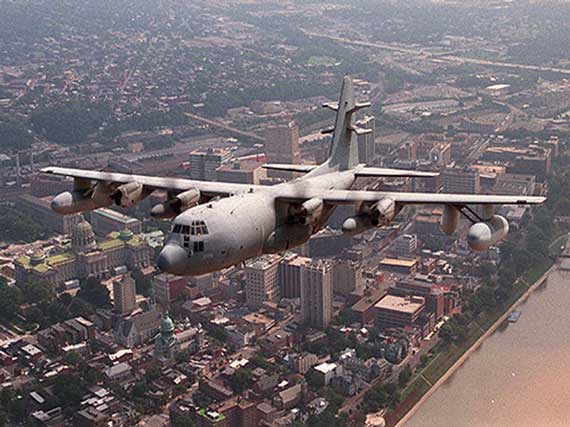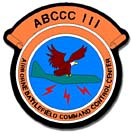
EC-130E ABCCC
 The
EC-130E ABCCC consists of seven aircraft that are used as
an Airborne Battlefield Command and Control Center. The
EC-130E is a modified C-130 "Hercules"; aircraft
designed to carry the USC-48 Airborne Battlefield Command
and Control Center Capsules (ABCCC III). These one-of-a
kind aircraft include the addition of external antennae to
accommodate the vast number of radios in the capsule, heat
exchanger pods for additional air conditioning, an aerial
refueling system and special mounted rails for uploading
and downloading the USC-48 capsule. The ABCCC has
distinctive air conditioner intakes fore of the engines
("Mickey Mouse ears"), two HF radio
probes-towards the tips of both wings, and three
mushroom-shaped antennas on the top of the aircraft - and,
of course, numerous antennas on the belly. The
EC-130E ABCCC consists of seven aircraft that are used as
an Airborne Battlefield Command and Control Center. The
EC-130E is a modified C-130 "Hercules"; aircraft
designed to carry the USC-48 Airborne Battlefield Command
and Control Center Capsules (ABCCC III). These one-of-a
kind aircraft include the addition of external antennae to
accommodate the vast number of radios in the capsule, heat
exchanger pods for additional air conditioning, an aerial
refueling system and special mounted rails for uploading
and downloading the USC-48 capsule. The ABCCC has
distinctive air conditioner intakes fore of the engines
("Mickey Mouse ears"), two HF radio
probes-towards the tips of both wings, and three
mushroom-shaped antennas on the top of the aircraft - and,
of course, numerous antennas on the belly.
As an Air Combat Command
asset, ABCCC (A-B-Triple-C) is an integral part of the
Tactical Air Control System. While functioning as a direct
extension of ground-based command and control authorities,
the primary mission is providing flexibility in the
overall control of tactical air resources. In addition, to
maintain positive control of air operations, ABCCC can
provide communications to higher headquarters, including
national command authorities, in both peace and wartime
environments.
The USC-48 ABCCC III
capsule, which fits into the aircraft cargo compartment,
measures 40 feet long, weighs approximately 20,000 pounds
and costs $9 million each. The ABCCC provides unified and
theater commanders an Airborne Battlefield Command and
Control Center (ABCCC), with the capability for combat
operations during war, contingencies, exercises, and
special classified missions. A highly trained force of
mission ready crew members and specially equipped EC-130E
aircraft to support worldwide combat operations. Mission
roles include airborne extensions of the Air Operations
Center (AOC) and Airborne Air Support Operations Center (ASOC)
for command and control of Offensive Air Support (OAS)
operations; and airborne on-scene command for special
operations such as airdrops or evacuations.
The ABCCC system is a
high-tech automated airborne command and control facility
featuring computer generated color displays, digitally
controlled communications, and rapid data retrieval. The
platform's 23 fully securable radios, secure teletype, and
15 automatic fully computerized consoles, allow the
battlestaff to quickly analyze current combat situations
and direct offensive air support towards fast-developing
targets. ABCCC, is equipped with its most recent upgrade
the Joint Tactical Information Distribution System, allows
real-time accountability of airborne tracks to capsule
displays through data links with AWACS E-3
"Sentry" aircraft.
EC-130E Commando Solo /
Rivet Rider
The EC-130E Commando Solo
(initially known as Volant Solo) is available to
commanders for localized targeting of specific avenues of
communication. The EC-130E exists in Comfy Levi and Rivet
Rider versions. Senior Hunter aircraft flying the SENIOR
SCOUT mission support Commando Solo aircraft. This
weapon system is the mainstay information operations
aircraft for peacekeeping and peacemaking operations and
humanitarian efforts which comprise a large percentage of
today's military missions. Commando Solo conducts
psychological operations and civil affairs broadcast
missions in the standard AM, FM, HF, TV, and military
communications bands. Missions are flown at the maximum
altitudes possible to ensure optimum propagation patterns.
The EC-130 flies either day or night scenarios with equal
success, and is air refuelable. A typical mission consists
of a single-ship orbit which is offset from the desired
target audience. The targets may be either military or
civilian personnel. Secondary missions include command and
control communications countermeasures (C3CM) and limited
intelligence gathering.
With the capability to
control the electronic spectrum of radio, television, and
military communication bands in a focused area, the
Commando Solo aircraft can prepare the battlefield through
psychological operations and civil affairs broadcasts.
These modified C-130Es provide broadcasting capabilities
primarily for psychological operations missions; support
disaster relief operations; and perform communications
jamming in military spectrum and intelligence gathering.
One oversized blade antenna is under each wing with a
third extending forward from the vertical fin. A
retractable wire antenna is released from the modified
beavertail, with a second extending from the belly and
held vertical by a 500 pound weight.
Capabilities include:
- Reception, analysis,
and transmission of various electronic signals to
exploit electromagnetic spectrum for maximum
battlefield advantage
- Secondary capabilities
include jamming, deception, and manipulation
techniques
- Unrefueled range 2800
NM
- Broadcasts in
frequency spectrums including AM/FM radio, short-wave,
television, and military command, control and
communications channels
Rivet Rider modification
includes:
- VHF and UHF Worldwide
format color TV
- Infrared
countermeasures [chaff/flare dispensers plus infrared
jammers]
- Vertical trailing wire
antenna
- Fire suppressant foam
in fuel tank
- Radar warning receiver
- Self-contained
navigation system
The modification added a
pair of underwing pylon mounted 23X6 foot equipment pods,
along with X-antennae mounted on both sides of the
vertical fin. Six aircraft have been modified to the Rivet
Rider configuration by the contractor, Lockheed Martin;
Ontario, California.
Commando Solo and Senior
Scout operations may be long or short range missions with
extended orbit delays planned at the aircraft operating
ceiling, and may require one or multiple air refuelings.
Some missions may require a combat profile, with a low
altitude profile enroute to the mission orbit area. The
electronic environment may be hostile, with enemy ability
to jam all communications radios and electronic
transmission systems; to intercept and use intelligence
information transmitted over nonsecure electronic systems
and radios; and to pinpoint the position of the aircraft
emitting any electronic transmission or signal.
Commando Solo supported
the operation JOINT GUARD mission by shutting down anti-SFOR
propaganda through radio and TV broadcasts over
Bosnia-Herzegovina in support of SFOR operations.
|